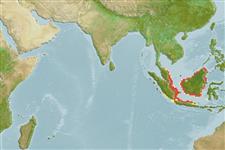>
Clupeiformes (Herrings) >
Dorosomatidae (Gizzard shads and sardinellas)
Etymology: Tenualosa: Latin, tenuis = thin + Latin, alausa = a fish cited by Ausonius and Latin, halec = pickle, dealing with the Greek word hals = salt; it is also the old Saxon name for shad = "alli" ; 1591 (Ref. 45335).
More on author: Bleeker.
Environment: milieu / climate zone / depth range / distribution range
Ecologia
marinhas; Água doce; estuarina; anádromo (Ref. 51243); intervalo de profundidade 0 - 50 m (Ref. 188). Tropical; 7°N - 9°S, 101°E - 119°E (Ref. 188)
Western Central Pacific: Malaysia, Indonesia (Java Sea and Sarawak, also affluent rivers) and Thailand (southern tip).
Tamanho / Peso / Idade
Maturity: Lm ? range ? - ? cm
Max length : 52.0 cm SL macho/indeterminado; (Ref. 188)
Espinhos dorsais (total): 0; Espinhos anais 0. Body moderately deep, belly with 30 to 31 scutes. A median notch on upper jaw distinguishes it from other similar clupeids, except Hilsa kelee. Gill rakers fine but not numerous. Caudal fin long, the lobes long and pointed. No series of dark spots along flank. Resembles T. toli, which has longer head but shorter tail; T. reevesii has many more lower gill rakers and a larger head.
Schooling in coastal waters and ascending rivers to breed. Feeds on zooplankton (Ref. 58784). Presumably its biology is similar to that of T. ilisha, but the fewer gillrakers suggest that it takes larger food organisms. A protandrous hermaphrodite (Ref. 55367).
Ciclo de vida ou comportamento de acasalamento
Maturidade | Reprodução | Desova | Ovos | Fecundidade | Larvas
A monandric species (Ref. 55367). Sex change occurs at a length of 19.0 cm TL and 0.9 year of age (Ref. 55367).
Whitehead, P.J.P., 1985. FAO Species Catalogue. Vol. 7. Clupeoid fishes of the world (suborder Clupeoidei). An annotated and illustrated catalogue of the herrings, sardines, pilchards, sprats, shads, anchovies and wolf-herrings. FAO Fish. Synop. 125(7/1):1-303. Rome: FAO. (Ref. 188)
Status na Lista Vermelha da UICN (Ref. 130435)
Ameaça para os humanos
Harmless
Uso pelos humanos
Pescarias: espécies comerciais
Mais informação
ReferênciasAquaculturaPerfil para aquaculturaEstirpesGenéticaElectrophoresesHereditariedadeDoençasProcessamentoNutrientsConversão de massa
ColaboradoresFotosStamps, Coins Misc.SonsCiguateraVelocidadeTipo de nataçãoÁrea branquialOtólitosCérebrosVisão
Ferramentas
Relatórios especiais
Baixar XML
Fontes da internet
Estimates based on models
Preferred temperature (Ref.
123201): 28.2 - 29.1, mean 28.8 °C (based on 266 cells).
Índice de diversidade filogenética (Ref.
82804): PD
50 = 0.5312 [Uniqueness, from 0.5 = low to 2.0 = high].
Bayesian length-weight: a=0.00912 (0.00433 - 0.01920), b=3.04 (2.87 - 3.21), in cm total length, based on LWR estimates for this (Sub)family-body shape (Ref.
93245).
Nível Trófico (Ref.
69278): 2.7 ±0.1 se; based on size and trophs of closest relatives
Resiliência (Ref.
120179): Elevada, tempo mínimo de duplicação da população menor que 15 meses (Assuming fec >10,000).
Fishing Vulnerability (Ref.
59153): Moderate to high vulnerability (45 of 100).
Nutrients (Ref.
124155): Calcium = 90 [66, 133] mg/100g; Iron = 2.46 [1.40, 4.15] mg/100g; Protein = 17.3 [16.5, 18.2] %; Omega3 = 0.586 [0.280, 1.275] g/100g; Selenium = 45.7 [18.3, 113.8] μg/100g; VitaminA = 14.1 [4.7, 42.9] μg/100g; Zinc = 1.11 [0.70, 1.89] mg/100g (wet weight); based on
nutrient studies.
